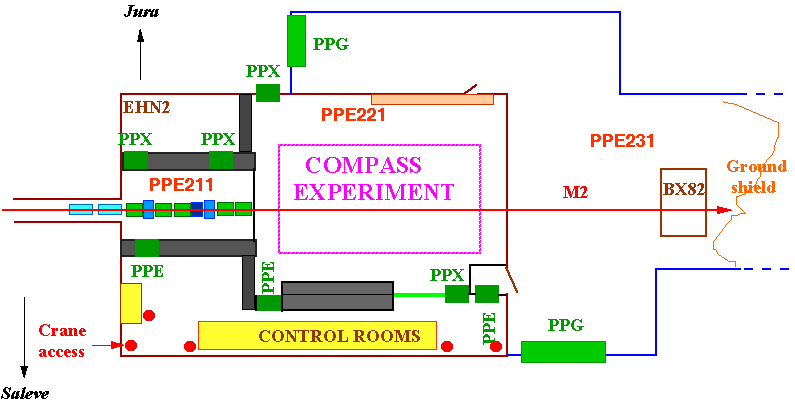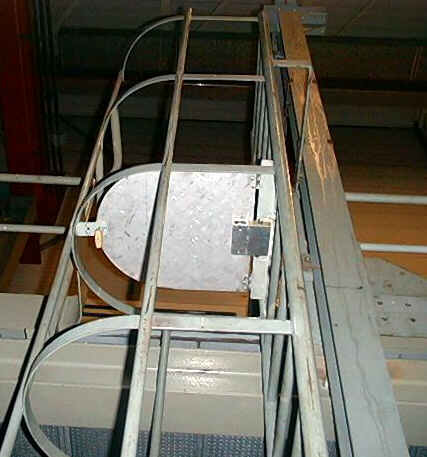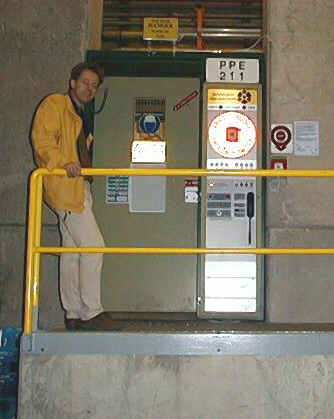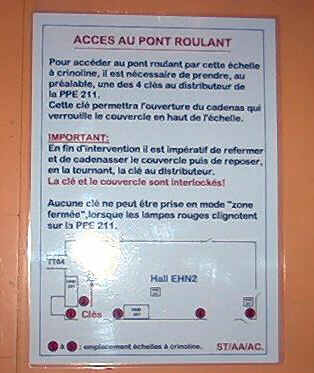| |
ACCESS SPECIALITIES IN EHN2 |
GENERAL INTRODUCTION
From the access point of view, EHN2 is divided in three areas:
- PPE211: The last part of the tunnel
through which the M2 beam is transported,
- PPE221: The main zone for the
COMPASS experiment,
- PPE231: A zone downstream of and behind
(i.e. on the Jura side of) the experimental hall.
It should be noted that the M2 beam can be operated in two main modes:
- As a muon beam with a maximum
authorised flux of 2 108 muons per SPS cycle. In this case it
is not possible to dump the beam before the exit of the experimental
hall. Therefore the outside area downstream of the hall (zone PPE231) is included in the
same interlock chain as the experimental zone PPE221 itself. The ground
level in this zone has been increased such that the muon beam is finally
dumped underground over a length of 1100 metres.
- As a hadron beam with a maximum
authorised flux of 108 hadrons per SPS cycle. As the target
and detectors of the experiment have a total thickness of about 20% of an
interaction length, the experiment has been shielded by a 1.6 metres
thick concrete wall on the control room (Salève side) of the hall.
On the back (Jura) side of the hall there is no such shielding, due to lack of space.
Therefore the area outside on the Jura side of zone PPE221 has been added to the PPE231
zone and thus included in the interlocked area. The last part of the beam
zone PPE211 is adequately shielded on both sides and therefore the area on the Jura
side of PPE221 can be left accessible with beam.
Please find below a schematic view of the situation in and around EHN2.

ACCESS TO THE CRANE
Due to the special layout of the M2 line, the muon flux above the beam
can be quite significant. Therefore it is forbidden to access the crane
when beam is on. For that reason the five access points to the crane
have all been blocked by lids that are interlocked
with the PPE211 zone. An example of such an access ladder is
shown in the picture below:

A contact makes sure that the PPE211 area cannot be closed when the lid is open.
As the lid is normally closed with a lock, a special key is required to
open the lid. This key can be taken when the PPE211 door, shown in the
picture below, is in key access or
free access mode.

When PPE211 is in one of these modes, the push-button for crane key release,
indicated on the picture below, lights up.

When this button is illiminated, one may push it and take one of the four
keys for crane access. These keys have the same function (though a
different format) as the keys for normal access to PPE211. With this key
one may obtain access to the crane. A little yellow light on door PPE211
flashes when one of the five lids is open (like in case of an emergency passage).
The zone can only be put back to closed mode when all lids are closed and
all keys are back in position.
Near all access points to the crane, as well as next to door PPE211, an
instruction sheet shows the location of the access points to the crane,
together with instructions. See the picture below for an example:

FINAL REMARKS
- There is one door that can be opened from within PPE221 and leads via a
ladder down to PPE231 from a passerelle on the Jura downstream side of PPE231.
This door serves as an emergency exit, but does not require a key from PPE221.
However, it is interlocked with PPE221. Opening this door is equivalent
to an meergency passage via one of the PPE221, PPX221 or PPG221 doors.
-
A new site monitor has been installed at the level of the COMPASS target,
at the CERN fence on the Salève side. This monitor, operational
since mid-1999, is predominantly sensitive to the effects of the hadron beam.
Last updated on 6 April 2000 by
L.Gatignon





